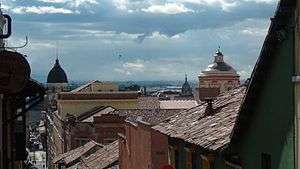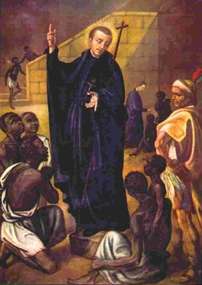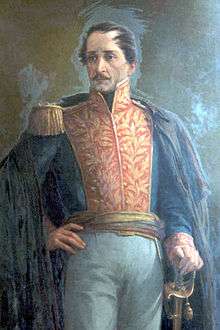St. Bartholomew Major College
| St. Bartholomew Major College Colegio Mayor de San Bartolomé | |
|---|---|
 | |
| Address | |
| 96 Bolivar Square, Bogota, Colombia | |
| Information | |
| Type | Jesuit, Catholic |
| Motto | Where there is a Bartolino there is a gentleman, where there is a Bartolina there is a Lady |
| Established | 1604 |
| Administrator | Alexandra P. Jimenez Suárez |
| Rector | Hugo A. Moreno Rojas, SJ |
| Grades | Pre-K through secondary |
| Gender | Coeducational since 1998 |
| Enrollment | 1,500 |
| Nickname | El Mayor |
| Affiliation | FLACSI |
| Vicedirector | Katia M. Quiroga González |
| Coordinator | Berly Jasmin Correa Pardo |
| Website | StBartColombia |
St. Bartholomew Major College, (Colegio Mayor de San Bartolomé), Bogotá, called at times National College of St. Bartholomew, College of St. Bartholomew, and College of the Society of Jesus in Santa Fe, is a coeducational, private preschool, primary, and secondary school under the direction of the Society of Jesus, founded on 27 September 1604 by the Archbishop of Bogota Bartolomé Lobo Guerrero[1] and the Jesuits Jose Dadey, Martin de Funes, Juan Bautista Coluccini, Martin de Torres, Bernabé de Rojas, and Diego Sanchez.[2]
It is the oldest Colombian school in continuous operation, with a 400-year history since its founding in 1604. The Pontifical Xaverian University in the colony grew out of it in 1623, and was restored in 1930 when the Conservative hegemony ended.[3] At St. Bartholomew, in 1826, the Central University of the Republic was founded, predecessor of the National University of Colombia, which brought together the National Library of Colombia, the College of San Bartolomé, and the university itself. It has been administered sometimes by the State and sometimes by the Jesuits, in whose hands it is today.
Major College of Saint Bartholomew, with its more than 412 years of existence, made a very significant contribution to Colombian society in the independence epoch. Many of its students and alumni played a key role in the emancipation process; it has generated real social mobility due to the preparation it gives its students. Twenty eight presidents of Colombia have graduated from the school, among other figures of national importance. In 2016 the school had approximately 1500 students.
Its baccalaureate building is a cultural and national monument by Decree 1584 of 11 August 1975,[4] and is located diagonally across from the southeast corner of Bolivar Square in Bogota. This building along with the Church of St.Ignatius and the Museum of Colonial Art in Bogota are part of the Jesuit block, which has been under restoration by the Society of Jesus and the Colombian Ministry of Culture.
History
From 1604-1766: College of the Society of Jesus in Santa Fe, Royal Major College and Seminary of St. Bartholomew, and Xaverian University

On 23 September 1604 six Jesuits came to Santafé from Cartagena to found the College of the Society of Jesus with support from the Archbishop of Bogota Don Bartolomé Lobo Guerrero.
The school was established on 27 September 1604 with a royal document authorizing its foundation. It opened on 1 January 1605 with 70 students, in two houses previously purchased to teach classes, by the parents Alonso de Medrano and Francisco de Figueroa in May 1600, located in the south-eastern corner of the main square of the city, in the same place where it is now.
The educational institution whose fourth centennial was celebrated in 2004, although it was originally called the College of the Society of Jesus in Santa Fe, today is called the St. Bartholomew Major College, a name inherited from the seminary of the city re-founded by the Archbishop Don Bartolomé Lobo Guerrero on 18 October 1605 and located in what is now the Palacio de San Carlos, in the block opposite the school. This seminary was entrusted to the leadership of the Jesuits. The seminarians and the borders both took their classes in the College of the Society of Jesus in Santa Fé, and so they were confused as a part of the same institution, and called the School and Seminary of St. Bartholomew.
On 1 November 1610 the foundation stone was laid for the Church of St. Ignatius. That same year St. Peter Claver came to work and study at the College and Seminary of St. Bartholomew.
By a bull of Gregory XV and by a royal document from Felipe IV issued in 1622, the College established itself as Xaverian University. Classrooms were in the current Museum of Colonial Art, which was part of the school building.
In 1704 the College which competed with the Rosary College took the name Royal Major College and Seminary of St. Bartholomew.
The Jesuits of St. Bartholomew brought the first printing press to Colombia.
From 1767-1886: College of St. Bartholomew and Central University
The year 1767 saw the expulsion of the Jesuits by the pragmatic sanction of Carlos III, and St. Bartholomew passed first into the hands of the colonial power and then to the Republic. With the books that were there, the first National Library was founded. By order of the Junta Virreinal de Temporalidades in 1772 the Seminary College was moved to the College of St. Bartholomew and Xaverian University, and it assumed all the educational functions.

In 1823, the State handed over to the Archdiocese the old convent of the Capuchins and chapel of San José for use of the Conciliar Seminary, which when it moved there took its name and did not maintain the original name Saint Bartholomew. This name was later assigned only to the secondary school that continued to operate in its traditional building. And since 1826 the university studies continuing there assumed the name First District University or Central University, now the National University of Colombia, inaugurated on 25 December 1826 in a ceremony at the church of St. Ignatius of the College of St. Bartholomew.
In 1842, the university and the college, together with the museum and the national library, were under the government control and directed by a single superior, who was rector of the University and of the College of St. Bartholomew.
By 1844, under President Pedro Alcantara Herran, the Jesuits returned and took charge of the Seminary. But six years later, on 18 May 1850, they received a decree of expulsion from Jose Hilario Lopez and left Santa Marta. Novices and those of Pasto went to Ecuador, the country from which they were expelled in 1852. In 1857 under the government of President Mariano Ospina Rodriguez the Jesuits returned and on 8 January 1859 took charge of the College of St. Bartholomew.
Two and a half years later, on 26 July 1861, Tomás Cipriano de Mosquera returned and decreed the banishment of the Jesuits; the school became a public school. By 1865, its administration was given to the Cundinamarca Department and in 1866 nationalized. By 1882, under Rafael Núñez's presidency, the Jesuits returned to Panama and to Pasto, Colombia.
From 1887 to 1928: National College of St. Bartholomew
In 1887 the Company of Jesus returned to Bogota and the National School of St. Bartholomew was again put under their direction. In 1891 the first baccalaureate took place. Jesuits returned to their former Church of St. Ignatius, with its custody of the La Lechuga monstrance.

In the year 1902, President Jose Manuel Marroquín and Archbishop Bernardo Herrera Restrepo, alumni of St. Bartholomew, officially consecrated the nation to the Sacred Heart of Jesus on June 22.

The school introduced football in Colombia around the year 1908, through Jesuit fathers Lisárraga and Leza, on the grounds of La Merced where national and international championships were held. The Obregon, former students of the Jesuits in London, were the first instructors. The DIMAYOR, during 25 years, honored the school with recognition for such initiative.
By 1910 the school presented for the first time in Colombia scientific films and lectures on polarized light and interference. In 1922 it introduced the first seismological observatory to Colombia and the first seismograph was established at the College. In 1923 the school cosponsored a Scout group, the oldest and most continuous in the country. It is currently sponsoring Scout Group 73 Nabusimake, founded in 1985.
From 1928 to 1941: St. Bartholomew College
In 1928 the National Congress recognized the autonomy of the College by Law 44. It ceded the use of the building that was considered national property and it became a private school with the name of St. Bartholomew College. In 1930 Xaverian University was reestablished in the College. In 1937, the National Congress by Law 110 claimed the building, forcing the Jesuits to construct a new building on the grounds of La Merced[5] while appealing to the Supreme Court on ownership of the building.
In 1937 the high school students formed a football team that in 1946 became the current Millonarios Football Club, the squad with the most professional football titles in the country.
From 1941 to 1952: National College of St. Bartholomew and College of St. Bartholomew La Merced

With the possibility of expropriation of the school building, the Jesuits built a new one on La Merced farm. They continued the College under the name of St. Bartholomew La Merced College, without renouncing the rights they had on the College of St. Bartholomew on Bolivar Square. Construction was subsidized by the sale of part of the farm land, for a neighborhood in La Merced. In 1941 classes began in the new school, and the old building was appropriated by the nation and run as a public school with the name of National College of St. Bartholomew.
On 10 January 10 1951, Laureano Gomez, president and graduate of St. Bartholomew secondary school, returned the national school to the Jesuits with a five-year contract,[5] by which they undertook to educate free 900 day pupils and 200 workers in night school. The government paid $25,000 pesos a month and ceded the building.[6] The plan was implemented immediately. The Society of Jesus thus had two schools in Bogota with similar names, the new St. Bartholomew College La Merced and the traditional St. Bartholomew Major College at Bolivar Square, since they'd decided to keep the old name which had a good reputation, but the two schools operated independently.
From 1952 to 1999: Major College of St. Bartholomew
On 19 December 1952 a settlement agreement was signed by which the College of St. Bartholomew Foundation was recognized, giving the government ownership of the building that housed Xavier University and is currently the square on the southeast corner of 7th and 10th streets. The government, in turn, conceded ownership of the rest of the building, the rebuilt sector, to the Foundation.(No. 333 Deed of Notary of the Circuit of Bogotá). In August 1955 a blueprint for remodeling the square was presented to Camilo Torres and on 17 June 1958 the name "Major College of St, Bartholomew" was recorded in the 4th Notary Office. The school magazine resumed this latest name, and its first photos were dedicated to the tower, which from 1943 to 1960 had been the school's coat of arms.

The College received the award Cross of Boyaca from President Julio Cesar Turbay Ayala in 1980. That same year it received the Andrés Bello award, given to the best educational establishments of Colombia (twice the first among 3600 schools), in accord with the results in the state examinations (ICFES).
On 9 September 1984, the Historical Archive of the College was reinstated and reorganized, with documents from 1905 to 1984; it is considered one of the most historically valuable in Colombia.
In 1996 the College went up to cyberspace, the first in Colombia and the first for the Jesuits in Latin America. In 1997 the College won the top award for excellence in school management in Bogotá. In 1998 the College began admitting women into the secondary school.

2000: St. Bartholomew College and preschool-primary
The school took second place throughout Colombia in the ICFES examinations in 2003, for schools that have more than 100 students in grade eleven. It also ranked ninth among all the more than 9500 schools.
In 2004 the 400th anniversary of the founding of the school was celebrated, during which it received the Simón Bolívar decorations in the Golden Cross category from the National Education Ministry; José Acevedo y Gómez in the degree of Grand Cross of the Council of Bogotá; Monsignor Ismael Perdomo in the degree of Great Cross of the Association of Catholic Schools of Colombia; and the Order ACODESI in the category Gold Cross of the association of Jesuit colleges of Colombia.
In 2004 also academic work extended to the pre-primary sector. The Jesuit Foundation for Social Service Carlos Gonzalez SJ terminated the educational work of Colegio Santa Catalina Labouré located in the Olaya neighborhood, to establish preschool and primary at the Major College of St. Bartholomew, which continues to the present. The primary was fully consolidated in 2006 and was recognized for its academic and human service to the educational community. It also received certification for its Quality Management System according to the requirements of ISO 9001: 2000. In 2009 it updated this certification to ISO 9001: 2008.
Years 2010 to date: St. Bartholomew College
In 2011 the night session was ended, for educated men and women who for various reasons did not obtain their baccalaureate. Starting in 2012 only day school was held.
In 2011 the school faced a serious financial crisis caused by the reduction of the subsidy that the government made to the students, which had decreased since 2004. As of 2012, the withdrawal of the subsidy is imminent since the government of Colombia does not recognize "the law 72 of 1983" which guarantees free education for students of the College for 90 years. So the College contemplated selling its historic headquarters to the ministry of the interior. After many meetings with students, parents, graduates, and Jesuits, the College of St. Bartholomew decided to maintain its headquarters at Bolivar Square, a historic setting and witness to great social transformations, where public demonstrations and social protests take place, as a sign of hope for the country in the coming generations, which is instilled in each of the students who are trained at the College, to serve society. As a result, the Society of Jesus began charging since 2013 a pension and enrolling new students.
In 2012 Fr. Hugo Moreno Rojas, S.J., became rector. Besides being president of FLACSI he has been responsible for administering the school. He reorganized its inner workings and has conducted important initiatives to modernize the school in its two venues, guaranteeing the educational quality and well-being of the entire educational community.
 Camilo Torres Square
Camilo Torres Square College inscription
College inscription Reception and main office off the square
Reception and main office off the square Central yard
Central yard Yard
Yard Yard and parking area
Yard and parking area Corridors
Corridors Jesuit community
Jesuit community Flags of College, Colombia, and Bogota
Flags of College, Colombia, and Bogota Inscription over Xaverian entrance
Inscription over Xaverian entrance Parking entrance
Parking entrance
Symbols
Major College of St. Bartholomew established as its institutional symbols its shield, flag, and the motto: "Where there is a Bartolino there is a gentleman, where there is a Bartolina there is a Lady" and the previous hymn in line with the manual of coexistence,[7] and also accepted the Tower of the Flag, Bartolina Scholarship, and Bartolina Cross for their historical significance.
Shield
The shield is circular, symbolizing cycles of generations that have passed through the halls of the school, which has a white edge for purity along with the inscription Colegio Mayor de San Bartolomé and 1604, the year in which the Society of Jesus founded the school. On the inside of the circle is the school flag with its colors (blue, red, blue), which are a symbol of nobility and tradition, and in the central and lower strip of the flag are the three letters IHS and three nails which are a symbol of the Society of Jesus, which has been in charge of the school since its founding.
Flag

This is composed of a horizontal rectangle with three stripes of equal proportion, where the upper and lower fringe are blue symbolizing justice, truth, and loyalty and a central red stripe symbolizs strength, victory, boldness, arrogance.
Hymn
The hymn of St. Bartholomew Major College has been modified throughout its history, as the school administration has gone through several hands, the last being the Society of Jesus. Three hymns were composed from the foundation until today: the first belonged to the College of St. Bartholomew and today is used by St. Bartholomew College La Merced. The second served the National College of St. Bartholomew. The last serves St. Bartholomew Major College and was composed in 1958 by V. José Tamayo, S.J., with music by John J. Briceño, S.J.

Flag tower
This is the official logo of the college and also belongs to the symbols of the current school,[8] as it was part of the school shield when it was the National College of St. Bartholomew. It is based on the building protruding from the front of the school at the corner of 7th and 9th streets which is called Tower of the Flag, because for many years the school's flag was hoisted there. This building was constructed by Hugo Stinnes House in the early twentieth century, along with the restoration of the school's colonial walls. The tower has six floors, with the first four used for school offices and the upper two serving as an observatory. It is crowned by a dome of bronze and a pole to raise the school flag. Its facade is neoclassical redolent of the Republic, like the whole. The only access is through the college facilities.
Bartolina Scholarship

This is the highest award of the St. Bartholomew Major College along with the Bartolina Cross, as these are awarded to graduates who successfully complete their high school studies at the school and also give promise of being integrally formed and prepared to serve others.
Bartolina Scholarship dates from the foundation of the seminary in 1605 and is included in the constitutions of the school, but it was standard in that epoch. The scholarships have distinguished illustrious Bartholomewans who have made a significant contribution to Colombian society, hence its importance and meaning today.
Prominent Bartolinos


National Monument
| Main building, Bolívar Square | |
|---|---|
 | |
| General information | |
| Address | La Candelaria, Bogota, Colombia |
| Design and construction | |
| Architect |
Juan Bautista Coluccini, SJ (17c colonial gallery) |
| 1919 - SW addition, 1948 - Plaza facade, 1955 - Camilo Torres plaza | |
The school building which houses the College of St. Bartholomew, and this part of the so-called Jesuit block of Bogota, is a National Monument of Colombia, a Heritage of Cultural Interest and district of the city of Bogotá by Decree 1584 of 11 August 1975, since in its halls the main figures in Colombian society have been educated, offering contributions and significant changes in Colombian society since colonial times, besides offering exemplary education to men and women who contribute to change and transform the country.
See also
External links
References
- ↑ "St. Bartholomew at 400 years" in El Tiempo, Bogotá, 26 September 2004.
- ↑ "400-Year History of St. Barthomolew" in El Espectador, Bogotá, 12 September 2004
- ↑ "Home | Pontificia Universidad Javeriana". www.javeriana.edu.co (in Spanish). Retrieved 2017-09-23.
- ↑ "Cultural patrimony" (PDF). web.archive.org. Archived from the original (PDF) on 2013-08-31. Retrieved 2017-09-23.
- 1 2 "St. Bartholomew, a Golden Wedding" in El Tiempo, Bogotá, 16 February 1991.
- ↑ "St. Bartholomew National School will be directed by the Jesuits" in El Tiempo, 11 January 1951, p.1.
- ↑ Manuel of Coexistence. Accessed 6 September 2015.
- ↑ Manuel of Coexistence. Accessed 6 September 2015.
Coordinates: 4°35′49.13″N 74°4′32.75″W / 4.5969806°N 74.0757639°W